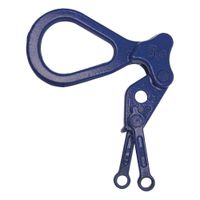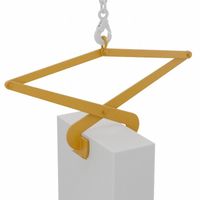Call +(254) 703 030 000 / 751 483 999 / 721 704 777
- Home
- Material Handling
- Lifting Pulling Positioning
- Below The Hook Lifting Devices
- Barrier Concrete Lifters
.....Read More
Frequently Asked Questions
What is a barrier lifting grab?
A barrier lifting grab is a specialized piece of equipment used in construction and material handling to lift and transport heavy barriers, such as concrete or steel road barriers, safely and efficiently. These grabs are designed to securely grip the barrier, allowing for easy lifting and placement without the need for manual handling, which reduces the risk of injury and increases operational efficiency.
The barrier lifting grab typically consists of a robust frame with adjustable arms or jaws that can be positioned to accommodate different sizes and shapes of barriers. The gripping mechanism is often powered by hydraulic or mechanical means, ensuring a firm hold on the barrier during lifting and transport. Some models may include rubber pads or other protective materials on the gripping surfaces to prevent damage to the barrier.
These grabs are usually attached to cranes, forklifts, or other lifting machinery, allowing for precise control over the movement and placement of the barriers. Operators can maneuver the barriers into position with minimal effort, making them ideal for use in road construction, infrastructure projects, and other applications where barriers need to be frequently moved or repositioned.
Safety features are a critical component of barrier lifting grabs, with many models incorporating locking mechanisms to prevent accidental release of the barrier during lifting. Additionally, some grabs are designed to automatically adjust to the weight and size of the barrier, further enhancing safety and ease of use.
Overall, barrier lifting grabs are essential tools in modern construction and logistics, providing a safe, efficient, and versatile solution for handling heavy barriers.
How do concrete lifting grabs work?
Concrete lifting grabs work by securely attaching to concrete elements, allowing them to be lifted and moved safely. These devices typically consist of a mechanical or hydraulic system that grips the concrete piece. The main components include:
1. **Gripping Mechanism**: This is the part that makes direct contact with the concrete. It can be a set of jaws, clamps, or pads that apply pressure to hold the concrete securely. The gripping mechanism is often adjustable to accommodate different sizes and shapes of concrete elements.
2. **Actuation System**: This system controls the opening and closing of the gripping mechanism. It can be manual, hydraulic, or pneumatic. Hydraulic systems are common due to their ability to exert significant force, ensuring a strong grip.
3. **Safety Features**: Concrete lifting grabs are equipped with safety features to prevent accidental release. These may include locking mechanisms that engage automatically when the grab is in the lifting position.
4. **Load Distribution**: The design of the grab ensures even distribution of the load to prevent damage to the concrete. This is crucial for maintaining the integrity of the concrete during lifting.
5. **Attachment Point**: The grab is connected to a crane or lifting device via a hook or shackle. This connection must be secure and capable of supporting the weight of the concrete.
In operation, the grab is positioned over the concrete element, and the gripping mechanism is engaged. Once secured, the crane lifts the grab, moving the concrete to the desired location. The process is reversed to release the concrete. Proper use of concrete lifting grabs enhances safety and efficiency in construction and material handling.
What are the safety precautions for using barrier lifters?
1. **Training and Certification**: Ensure operators are properly trained and certified to use barrier lifters. They should understand the equipment's operation, limitations, and safety features.
2. **Pre-Operation Inspection**: Conduct a thorough inspection of the barrier lifter before use. Check for any signs of wear, damage, or malfunction in the lifting mechanism, hooks, and chains.
3. **Load Assessment**: Verify the weight and dimensions of the barrier to ensure it is within the lifter's capacity. Overloading can lead to equipment failure and accidents.
4. **Secure Attachment**: Ensure the barrier is securely attached to the lifter. Use appropriate slings, chains, or hooks, and double-check all connections before lifting.
5. **Clear Communication**: Establish clear communication signals between the operator and ground personnel. Use hand signals or radios to coordinate movements and ensure everyone is aware of the lifting process.
6. **Safe Work Area**: Keep the work area clear of unnecessary personnel and obstacles. Ensure that the lifting path is free from overhead obstructions and that the ground is stable.
7. **Personal Protective Equipment (PPE)**: Require all personnel involved in the lifting operation to wear appropriate PPE, such as hard hats, gloves, and steel-toed boots.
8. **Controlled Movements**: Operate the lifter smoothly and avoid sudden movements. Sudden jerks or swings can destabilize the load and lead to accidents.
9. **Weather Conditions**: Be mindful of weather conditions. Avoid lifting operations during high winds, rain, or other adverse weather that could affect visibility or equipment stability.
10. **Emergency Procedures**: Have emergency procedures in place. Ensure all personnel know how to respond in case of equipment failure or an accident.
11. **Regular Maintenance**: Perform regular maintenance on the barrier lifter according to the manufacturer's guidelines to ensure it remains in safe working condition.
How do you maintain barrier lifting grab accessories?
To maintain barrier lifting grab accessories, follow these steps:
1. **Regular Inspection**: Conduct routine inspections before and after each use to check for wear, damage, or deformation. Look for cracks, corrosion, or any signs of fatigue in the metal components.
2. **Cleaning**: Keep the accessories clean by removing dirt, debris, and any corrosive substances. Use appropriate cleaning agents that do not damage the material.
3. **Lubrication**: Apply suitable lubricants to moving parts to ensure smooth operation and prevent rust. Follow the manufacturer's recommendations for the type and frequency of lubrication.
4. **Check Fasteners**: Ensure all bolts, nuts, and other fasteners are tight and secure. Replace any that are worn or damaged.
5. **Test Functionality**: Regularly test the grab's functionality to ensure it operates correctly. This includes checking the gripping mechanism and any locking features.
6. **Storage**: Store the accessories in a dry, clean environment to prevent exposure to moisture and corrosive elements. Use protective covers if necessary.
7. **Training**: Ensure that all operators are trained in the correct use and maintenance of the equipment to prevent misuse and potential damage.
8. **Documentation**: Keep detailed records of all inspections, maintenance activities, and any repairs performed. This helps in tracking the condition and performance over time.
9. **Follow Manufacturer Guidelines**: Adhere to the manufacturer's maintenance schedule and guidelines for specific care instructions and replacement intervals.
10. **Professional Servicing**: Engage professional services for periodic thorough inspections and maintenance, especially for complex or heavily used equipment.
By following these steps, you can ensure the longevity and safe operation of barrier lifting grab accessories.
What is the weight capacity of concrete lifting tongs?
The weight capacity of concrete lifting tongs varies depending on the specific design, manufacturer, and model. Generally, these tongs are engineered to handle a range of weights, typically from a few hundred pounds to several tons. Standard models might have capacities ranging from 1,000 pounds (approximately 450 kilograms) to 10,000 pounds (approximately 4,500 kilograms) or more.
For heavy-duty applications, industrial-grade lifting tongs can be designed to handle even greater weights, sometimes exceeding 20,000 pounds (approximately 9,000 kilograms). The capacity is determined by factors such as the materials used in construction, the design of the tong arms, and the mechanism of grip and lift.
It is crucial to consult the manufacturer's specifications and guidelines to determine the exact weight capacity of a particular set of lifting tongs. Additionally, safety factors are often included in the design to ensure that the tongs can handle slightly more than their rated capacity under controlled conditions. However, it is essential to never exceed the specified weight limit to avoid accidents or equipment failure.
When selecting lifting tongs, consider the specific requirements of the task, including the size and shape of the concrete elements to be lifted, as well as the working environment. Proper maintenance and regular inspections are also necessary to ensure the tongs remain in good working condition and retain their rated capacity.
Can barrier lifting grabs be used for other materials besides concrete?
Yes, barrier lifting grabs can be used for materials other than concrete, but their suitability depends on the design and specifications of the grab. These devices are primarily designed to handle precast concrete barriers, but they can also be adapted or specifically designed to lift other heavy, uniform objects.
For instance, barrier lifting grabs can be used for stone blocks, steel beams, or large wooden logs, provided the grab's gripping mechanism and weight capacity are appropriate for the material's size, shape, and weight. The key factors to consider include the grab's jaw design, which must securely hold the material without causing damage, and the lifting capacity, which must match or exceed the weight of the material being lifted.
Additionally, the surface texture and fragility of the material are important. For delicate materials, the grab may need padded or specially coated jaws to prevent surface damage. For irregularly shaped or non-uniform materials, custom grabs or adjustable models may be necessary to ensure a secure grip.
In summary, while barrier lifting grabs are versatile, their use for materials other than concrete requires careful consideration of the material's characteristics and may necessitate modifications or specialized equipment to ensure safe and effective handling.
How do you choose the right barrier lifting grab for a project?
To choose the right barrier lifting grab for a project, consider the following factors:
1. **Load Capacity**: Ensure the grab can handle the weight of the barriers you need to lift. Check the manufacturer's specifications for maximum load capacity.
2. **Barrier Dimensions**: Match the grab to the size and shape of the barriers. Consider the length, width, and height to ensure a secure fit.
3. **Material Compatibility**: Ensure the grab is suitable for the material of the barriers, whether concrete, steel, or another material, to prevent damage and ensure safety.
4. **Type of Grab**: Choose between mechanical, hydraulic, or vacuum grabs based on the project's requirements and available equipment.
5. **Safety Features**: Look for grabs with safety mechanisms such as locking systems, anti-slip features, and overload protection to prevent accidents.
6. **Ease of Use**: Consider the ease of attachment and detachment, as well as the level of operator training required.
7. **Environmental Conditions**: Assess the working environment, including weather conditions and terrain, to ensure the grab can operate effectively and safely.
8. **Regulatory Compliance**: Ensure the grab meets industry standards and regulations for safety and performance.
9. **Cost and Budget**: Balance the cost of the grab with the project budget, considering both initial purchase and long-term maintenance costs.
10. **Supplier Reputation**: Choose a reputable supplier with a track record of quality products and reliable customer support.
11. **Project Timeline**: Ensure the grab is available within the project timeline to avoid delays.
By evaluating these factors, you can select a barrier lifting grab that meets the specific needs of your project, ensuring efficiency and safety.


